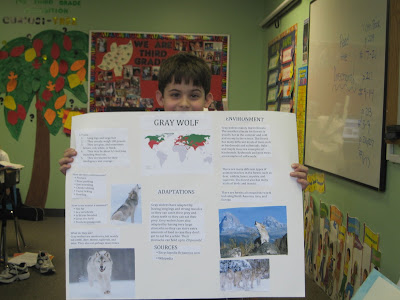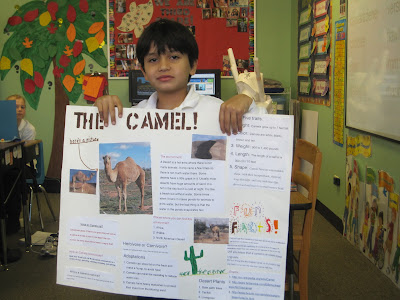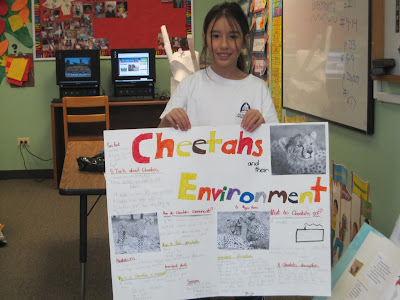On Monday we conducted a Science Experiment where we tried to get raisins to dance. No, not like the California Raisins (although this joke was lost on the kids)...but real raisins.
What you need:
Clear soda
raisins
clear glass cup
corn kernels
pinto beans
First we filled the glass with soda. Then we dropped in the pinto beans, most sunk, some floated.
Then we tried the corn kernels - they bounced around.
Lastly, we got our dancing raisins - when plopped in the soda, the raisins are surrounded by the carbon dioxide in the soda (carbonation) and it causes the raisins to rise to the top, then the bubbles pop and the raisin sinks again - then back up. And we had out Dancing Raisins!
Monday, April 18, 2011
Readers' Theater! Looking to the Future...
Yet another Readers' Theater showcasing the wealth of personalities, creativity and dramatic skills in Third Grade!
This week's Readers' Theater was all about the future - from dogs to traveling to family-life.
Family 3000
This week's Readers' Theater was all about the future - from dogs to traveling to family-life.
The Robodogs of Greenville
Family 3000
Anywhere Anytime Travel Agency
Blobs in a Bottle!
On Thursday we conducted a Science experiment that not only looked at what happens when oil and water are mixed together...but then what happens when we had some food coloring (for affect) and antacid tablets (like Alka Seltzer)
The results were...our very own, home-made lava lamps!
What you need:
Water
Oil
Food Coloring
Antacid Tables
Clear Bottle with lid
First we poured the water in the bottle. Then before we added oil we wrote hypotheses about what each of us thought would happen. Then we poured the oil in and observed. Everyone was shocked at how the water and oil just did NOT want to mix. But WHY? That IS the question.
Ask your kids...hint...oil is less dense than water...
But as cool as that was to see then we added food coloring. We hypothesized what would happen...and we were more educated this time after watching the oil and water. And yet...still in awe that the food coloring did not color the oil - JUST the water!
Finally we hypothesized what would happen if we added Alka Seltzer tablets (antacids) to the mix. When we added them...we got our lava lamp! But WHY? Again - that IS the question. The citric acid in the antacid tablet reacts with the water and it releases carbon dioxide gas (carbonation) which rise to the top taking the colored liquid along for the ride!
I hope the kids showed you this with their mix and tablets they took home!
The results were...our very own, home-made lava lamps!
What you need:
Water
Oil
Food Coloring
Antacid Tables
Clear Bottle with lid
First we poured the water in the bottle. Then before we added oil we wrote hypotheses about what each of us thought would happen. Then we poured the oil in and observed. Everyone was shocked at how the water and oil just did NOT want to mix. But WHY? That IS the question.
Ask your kids...hint...oil is less dense than water...
But as cool as that was to see then we added food coloring. We hypothesized what would happen...and we were more educated this time after watching the oil and water. And yet...still in awe that the food coloring did not color the oil - JUST the water!
Finally we hypothesized what would happen if we added Alka Seltzer tablets (antacids) to the mix. When we added them...we got our lava lamp! But WHY? Again - that IS the question. The citric acid in the antacid tablet reacts with the water and it releases carbon dioxide gas (carbonation) which rise to the top taking the colored liquid along for the ride!
I hope the kids showed you this with their mix and tablets they took home!
The Chicks have Hatched!
 |
| Third Grade with the chicks! |
The children have the opportunity to see the eggs in the incubator. They also get to take part in "egg candling," where they use a light to illuminate the inside of the egg to see how the chicks are doing. The kids get to see a lot of movement and the embryo.
Finally, after a much awaited 21 days the chicks hatch and each classroom has the opportunity to hold and examine the baby chicks. Here are some pictures of the kids with the chicks.
It was hard to say good-bye to the chicks, but they are now living happy on a farm with many other chicks and chickens.
Happy St. Patrick's Day!
To celebrate St. Patrick's Day, I always like to share a favorite Irish legend that a friend broke back from Ireland with her for my husband and me. "The Salmon of Knowledge," is a myth about an old wise man who sought the Salmon of Knowledge his whole life. If a man was to catch and eat this fish he would be filled with all the wisdom in the world. Unfortunately for the elder, his young apprentice, whom he made catch and cook the fish accidentally tasted a drop of the Salmon and inherited all the wisdom. I like to jest with the kids that because my last name is Salmon - I am filled with this wisdom :)
In addition, the school enjoyed an assembly in which Ms. Scanlon and Ms. Eileen shared their memories of Ireland as well as bits of Irish history. Mrs. McCormac also shared with the school the history behind St. Patrick's Day and why people wear green, orange and white. She also shared some true-Irish traditions, such as girls wearing the colored ribbons in their hair.
Following the presentations we had some very special performers - Irish Dancers - and they were our own OSM students, including Mary and Jane from our class! They were awesome. Check out the videos of the different dances they shared with the school.
Cheers to the dancers for an awesome show!
Charlie and the Chocolate Factory Live!
 |
| WONKA! 2nd and 3rd Graders waiting outside the theater for the show! |
The 2nd and 3rd Graders took a trip to Green Emerald Theater to catch the play version of Charlie and the Chocolate Factory. It was great for the kids to see yet another version of the famous and popular story by Roald Dahl.
Friday, March 11, 2011
Summer Around the World 2011 - Sign Up Before Its Too Late!
Take a Trip Around the World with
Old St. Mary's School
"Summer Around the World."
"Summer Around the World."
Just a reminder that registration forms and deposit are due next week on Thursday, March 17 in order to secure a spot in OSM’s summer enrichment program.
If you need an extra program brochure and form, or if you have any questions please contact Mrs. Alyssa Salmon: asalmon@oldstmarys.com.
In regards to some feedback, we realize that there may be a conflict here or there, one particular being the White Sox Baseball Camp which overlaps with the first week of the camp. If you are genuinely interested in the camp, yet have a small conflict please feel free to contact Alyssa Salmon to discuss accommodations.
Also, in response to several inquiries, students currently enrolled in preK-2, moving onto kindergarten next year, qualify for the full-day school age camp! This is a great opportunity to bridge their preschool and academic career and ease any butterflies they may have about their kindergarten year.
The teachers working the summer program are busy planning and scheduling exciting trips and activities. We look forward to working with all our campers this summer!
We hope to see you as we depart for China
Young Scientists
Which soil will grow grass the best?
 |
| Mary, Maggie and Patrick getting some sandy soil |
 |
| Caroline, Delaney, Kaya and Brendan getting loam soil. |
 |
| Clive, Oscar, Delaney, Katie, Trent and Lance gathering clay soil. |
But what does "best" mean? It could mean the tallest, the most, the greenest, the healthiest, the fastest... Which would the students observe? Well, that is what we learned in this science lesson. Each student defined their operational definition, to base their hypothesis and observations around. Some students defined "best" as the which grew the most, another group defined "best" as the tallest and the third group defined "best" as the fastest. Once we defined our operational definition. We went through the steps of a Scientific Investigation. Here Delaney and Jane explain this to you...
We listed out materials and steps - the scientific design. Here are Maggie and Mary explaining the soils.
Then we went through the steps of the experiment. Maddie and Oscar explain one of the first steps.
Here Trent, Caroline, Clive and Kaya explain the last few steps.
Then finally the students wrote their hypothesis, based on their operational definition.
Here Brendan, Katie and Patrick share their hypotheses.
Angelina also shares her hypothesis.
Finally, Valerie and Lance share their hypotheses and explain what the next steps are.
In the next couple weeks we will observe the different cups of soil and seeds and determine whether our hypothesis were correct or incorrect. Look for the blog post with that update to come in a couple weeks!
Wednesday, March 9, 2011
Our Trip to the Nature Museum
 |
| Mrs. Salmon's Third Grade Class Trip to the Nature Museum |
Our first at the museum was a special workshop where we investigated red worms. The museum staff was blown away by all the wonderful facts and information our class had to share in the workshop. Here are some pictures of our investigations.
Here is a clip from all the investigations, followed by several pictures of the whole trip.
 |
| Showing the workshop leader how much we know! |
 |
| One of the red worms we examined |
 |
| Oscar, Clive and Trent checking out their worms |
 |
| Brendan, Caroline, Angelina and Mary using magnifying glasses to closely examine their worms |
 |
| Jane. Kaya and Katie examining their worms |
 |
| Patrick, Lance and Maggie examining their worms |
 |
| Check them out - some were slow some were escape artists! |
 |
| If you look closely you can tell which is their head and where their 4 hearts are! |
 |
| Then we returned them safely to their soil to help make compost |
 |
| The worms were happy to go home I'm sure |
After our worm investigation we enjoyed a nice lunch and then walked through the museum. We even got to meet a female corn snake that just had babies! Here are some museum employees teaching us about her.
 |
| We know a lot about reptiles, just ask! |
 |
| Checking out the corn snake |
 |
| Then we got to touch her skin, it was so silky, we were shocked |
Finally we hit up the Butterfly Habitat. We discussed the life cycle of a butterfly and had a class challenge as to who could find and name the most butterflies! As you can see some of us must use flowery/fruity shampoo because the butterflies liked us!
 |
| Jotting down the names of butterflies as they observed them |
 |
| This butterfly stuck with Lance the whole time! |
 |
| Another hitch hiker on Oscar |
 |
| Valerie must use a nice smelling shampoo! |
 |
| Examining different butterflies and moths |
 |
| Who knew there were so many butterflies and moths to see? |
Mammals, Ecosystems and Adaptations!
The students all did a wonderful job putting together their Mammal and Ecosystem project. Each student chose an environment from: forest; wetland; desert; tundra and grassland. They then picked out a mammal that lives in that environment. They researched both and created a poster and presentation on what they learned.
Their focus given their research on both the mammal and its environment was on the adaptations the mammal has developed to survive and prosper in their ecosystem.
Kudos to every student on a job well done!
Their focus given their research on both the mammal and its environment was on the adaptations the mammal has developed to survive and prosper in their ecosystem.
Kudos to every student on a job well done!
 |
| Angelina taught us about river otters from the wetland Did you know that they have clear eyelids so they can see under water but not hurt their eyes |
 |
| Brendan taught us about the wolf from the forest Did you know that wolves' stomachs can hold 20 pounds of food? |
 |
| Clive taught us about the camel from the desert Did you know camels have thick hairy lips to protect them if they eat or drink from a cactus? |
 |
| Delaney taught us about the white-tailed prairie dog from the grassland Did you know that if a young prairie dog gets lost another family will adopt it - but will turn away a lost adult? |
 |
| Jane taught us about the black-tailed prairie dog from the grassland Did you know that black-tailed prairie dogs don't really need to drink water because they get enough from the foods they eat? |
 |
| Katie taught us about the tree kangaroo from the forest Did you know that they are endangered and they get their name because they have pouches to carry their young? |
 |
| Kaya taught us about the harp seal from the tundra Did you know that they get their name because they have a harp design on their backs and they can stay under water for 30 minutes! |
 |
| Lance taught us about the raccoon from the wetlands Did you know that they go into a threat posture to scare or intimidate predators? |
 |
| Maddie taught us about the American pika from the tundra Did you know the male sings during the mating season and baby pikas are born hairless? |
 |
| Maggie taught us about the cheetah from the grassland Did you know that cheetahs are endangered and that rulers in Egypt and India use to tame cheetahs? |
 |
| Mary taught us about muskrats from the wetland Did you know that they got their name from the musky odor they give off and that they have scent glands in their tails? |
 |
| Oscar taught us about the arctic fox from the tundra Did you know that they have the warmest fur of any mammal? |
 |
| Patrick taught us about the leopard from the forest Did you know that a leopard sounds like an elephant when it is crying but can be extremely quiet to stalk their prey? |
 |
| Trent taught us about the meerkat from the desert Did you know that its tail can be as long as its body and they use this to stand or look bigger? |
 |
| Valerie taught us about the black gibbon monkey from the forest Did you know that they can be heard from a mile away? |
Subscribe to:
Comments (Atom)























